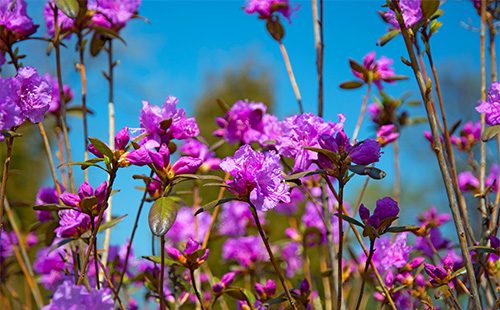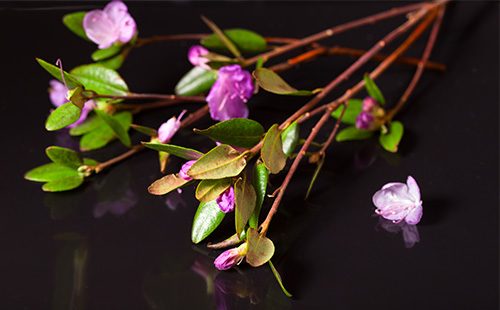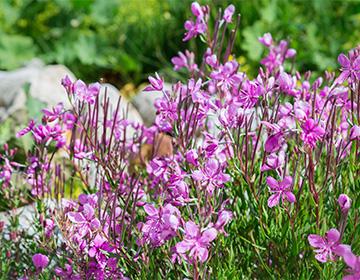The content of the article
In the traditional medicine of Russia, rosemary began to be used relatively recently - from the 19th century, while in folk practice - from the 16th century. Doctors of Germany and Sweden have long noted the antitussive, anti-inflammatory and diuretic properties of the plant.
Botanical characteristic
Marsh rosemary grows on hyper-moistened soils - in wetlands, near bogs, rivers, and other water bodies. The plant is common in the forest zone of Europe. On the territory of Russia it is found in the north of the European part, west and east of Siberia, as well as in the Far Eastern region. The culture is unpretentious - perfectly survives on acidic soils. It is sometimes used by gardeners, as it can grow in the shade, actively develops in one place up to 30 years. Often forms thickets, but is sensitive in terms of external influences. When the root system is damaged, the plant dies.
Herbalists say rosemary is easy to recognize. The plant exudes a pleasant, but suffocating aroma over long distances. Once in the swamp, it’s enough to smell. The plant can be precisely determined by morphological characteristics.
- General form. Evergreen shrub plant from the Heather family. The root system is superficial.
- Shoots. Leafy shoots multiply grow from a single root system. They stretch upwards, reaching 1.5 m. On each plant there are green shoots that grew in the same year. They are soft, and the entire surface is densely covered with brownish glandular hairs. In the second year of development, the stems are lignified.
- Leaves. Located on the stems in turn, fastened with short petioles. The surface is leathery, glossy. The upper part of the sheet is covered with glands. The lower one is lighter, pubescent with red hairs. The shape of the sheet plate is elongated, lanceolate. The length can reach 4.5 cm. The edges are solid, bent down. Width - 1.5 cm.
- Flowers. Formed on two-year shoots in May-July. They have the right shape. Corolla consists of five white petals. One racemose inflorescence, forming at the top of the shoot, may consist of 25 flowers. Each flower is seated on a glandular pubescent peduncle.
- Fruit. They begin to ripen in August-September. They have the shape of elongated oval boxes. Inside, there are five nests, in each of which small seeds are concentrated. Boxes open when ripening, and the seeds scatter. The surface of each fruit is glandular-pubescent.
The plant multiplies in parts of the rhizome, shoots, seeds, forms dense thickets in which the stupefying "spirit" reigns. Young shoots exude the most intense smell, since the most glands are on their surface. Essential oil accumulates mainly in the leaves (about 8%), in the stems it is much less (up to 2%). The flowers revealed a concentration of up to 4%. Every year the plant develops, the amount of ether decreases.
Harvesting of raw materials
Ledum raw materials should be collected in late summer - early autumn. To do this, use secateurs or clippers. It is advisable to use a respirator or gauze dressings. It is not recommended to work with the plant for longer than three hours a day.
- Collection. It is carried out in places of mass growth, not more than once every three years in one area. Young green shoots are cut. With manual collection, you can not tear them with roots or undermine from the soil - this is fraught with death of thickets. Ideally, only the upper leaf part is collected.
- Training. The shoots are sorted out for dry or spoiled elements. Cut into pieces up to 10 cm long.
- Drying. They are laid out in a layer up to 7 cm on a pallet closed with paper or cloth. It is necessary to dry quickly. For this purpose, use warm attics with through ventilation or dryers, adhering to a regime of up to 40 ° C. Dried, regularly tedding shoots.

Composition
Useful properties of the culture are determined by the content in its chemical composition of essential oil and other biologically active substances.
The oil contains volatile compounds, including:
- palustrol;
- icebreaker;
- cymol;
- geranyl acetate;
- bicyclic alcohols.
Volatile substances are able to be absorbed into the bloodstream and excreted through the epithelium of the lungs. Due to this, the plant exhibits expectorant properties. Also, marsh rosemary is characterized by a local antiseptic effect in the bronchi, stimulation of the ciliated epithelium and the relaxation of smooth muscles. Along with liquefaction of sputum and activation of its excretion, the plant relieves spasms, eliminates coughing attacks without affecting the cough center in the brain.
Glycosides were detected in the culture. The most important are arbutin and ericoline. The first is characterized by a diuretic effect, combined with anti-inflammatory and antibacterial effects. The second is able to relieve spasm of smooth muscles, ensuring the elimination of pain in the abdominal region, moderate vasodilation and lowering blood pressure.
Other important components of a medicinal plant:
- flavonoids - improve blood circulation, strengthen blood vessels, have antioxidant effects;
- coumarins - thin the blood, stimulate the immune system, have anti-inflammatory properties;
- anthocyanins - have a comprehensive beneficial effect on all body systems, prevent the formation of tumors;
- nutrients - vitamins and minerals have a general strengthening effect, stimulate the immune system, regulate metabolism;
- tannins - have regenerative, hemostatic, anti-inflammatory and antimicrobial properties;
- volatile - eliminate pathogenic microorganisms, activate defenses.
Like other representatives of the Vereskov family, marsh rosemary contains andromedotoxin. This organic compound has neurotoxic properties - it stimulates the nervous system up to its exhaustion and complete inhibition. Toxin is present in the pollen of flowers, so they are most dangerous to humans. There are known cases of poisoning by plant vapors, honey collected from it. (Animals suffer even in contact with dry and green grass).
Healing properties
According to the experience of traditional and traditional medicine, as well as scientific research data, rosemary is appropriate to use in the following cases.
- For diseases of the respiratory tract. Various lung diseases are treated with shoots: infectious, inflammatory, allergic, autoimmune. A strong antibacterial effect allows the plant to be used for pertussis, tuberculosis, bacterial bronchitis and pneumonia, with acute respiratory viral infections (cough and rhinitis). Effectiveness in the treatment of asthma has been proven - phyto-medication helps to significantly reduce the frequency and intensity of bronchospasm attacks. In the complex treatment of colds, it has a diaphoretic, antipyretic and tonic effect.
- With skin diseases. Thanks to the essential oil and tannins, the culture copes with bacterial and parasitic skin lesions. In European medicine it is used for dermatitis, scabies, eczema, scrofula, mycoses. It has healing activity - it accelerates the granulation of wounds and epithelization of the injured surface, eliminates the joined infection, and also prevents complications such as suppuration and the inflammatory process.
Also known about the experience of using ledum in the treatment of hypertension. In this case, the vasodilating and moderate diuretic effects of the plant are triggered. Traditional medicine in Germany uses culture as a choleretic drug, it is recommended in the complex treatment of gout and rheumatism (due to a systemic anti-inflammatory effect). There is evidence of successful herb therapy for angina pectoris. She also has tonic properties.
Grass is used in limited doses, carefully observing the formulation of preparations. The plant is actively used in homeopathy - on its basis they create repeatedly diluted agents that are considered safe for health.
Prescription Drugs
Extracts from the plant can be used inside and out. Herbalists do not recommend making tinctures on vodka, since alcohol as an extractant increases the concentration of toxins in the prepared products. For external use, oil extraction is better.
Infusion
Features The drug is used for coughing, in the complex treatment of tuberculosis, with kidney diseases and high blood pressure. In case of serious skin injuries, the infusion is used for washing. It is advisable to brew fresh medicine every two days and store it in the refrigerator.
Preparation and use
- A teaspoon of crushed raw materials is placed in a tightly closed container.
- The grass is poured with boiling water (a glass), covered with a lid, left to infuse for eight hours. (You can brew for the night).
- After filtering, the drug is used orally in a tablespoon three times a day.
Butter
Features The tool is suitable for the treatment of any skin problems, except for large wounds and severe burns, when the use of fatty bases is prohibited. Fungus of the feet and nails, allergies, dermatitis, redness, irritation, incomprehensible itching - all this can eliminate the oil.
Preparation and use
- Pour a couple of tablespoons of crushed raw material into a metal container.
- Pour with five tablespoons of vegetable oil.
- Cover the container, heat in a water bath for 12 hours, periodically bringing the water to a boil.
- Filter, carefully squeezing the raw materials.
- Apply to the affected areas with a thin layer, lightly rub.
- The skin is treated up to three times a day.

Contraindications
Due to the toxins in the composition, the culture can not be used in the treatment of children, pregnant, lactating. In other cases, treatment with a plant should be agreed with the doctor. Possible side effects:
- nausea;
- insomnia;
- allergic rash;
- pressure drops.
If any unwanted reactions occur, you must stop taking the herbal product and consult a doctor. If inhalation of Labradion vapors is possible, nausea, vomiting, severe headache, confusion, dizziness, irritability with drowsiness occurring after it are possible. With such effects, the help of a doctor is also required, since they can signal poisoning.

